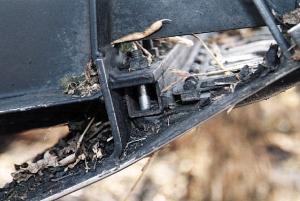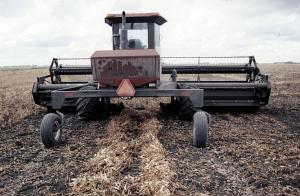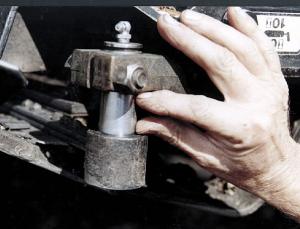2000 - Volume #24, Issue #6, Page #20
[ Sample Stories From This Issue | List of All Stories In This Issue | Print this story
| Read this issue]
Inexpensive Swather Conversion Gets Cutterbar Down Lower
 |
 |
 |
They heard about an idea developed by Bill Elias, Morden, Manitoba, and went to work to convert the 25-ft. MacDon 960 header on their self-propelled Premier 2900 swather. First step in the conversion was to take the knife guards off. Then they installed a length of 1 1/4-in. square steel tubing underneath the bar and mounted the guards below that. They had to replace the bolts with new ones to fit, but the result was the knife was moved 1 1/4 in. lower.
Once the guards were back in place, there was still the matter of the hold- down brackets for the sickle. There was no way to bolt them lower, so Siemens solved that problem by welding 3/8-in. square steel key stock, cut 3-in. long, onto the square tubing in place of the brackets. He says the key stock works as well as the hold -down brackets.
To give the sickle room to move back and forth, they had to cut a small notch in the header's end divider. They had a local machine and welding shop make the cut and then reinforce the divider so there'd be less likelihood it would break if it hit something.
This simple change lowers only the knife, Siemens says. Everything else about the header works the same.
Lowering the knife mounting also meant that the shaft that attaches the pitman arm to the knife was 1 1/4 in. too short. Siemens says the machine shop solved this problem by making a new, longer shaft out of a piece from a hydraulic cylinder. "The diameter of the hydraulic cylinder shaft was the same as the one we were replacing, so all they did was cut it the right length, drill through the center, and install a grease zerk so we could grease the needle bearing in the knife head," Siemens says.
Before the conversion, skids on the header kept the knife up out of the dirt. Now they can actually run the knife in the dirt if they need to, in order to cut the beans as low as necessary. While they're able to harvest a lot more beans this way, they do have to change knives at least once during the season.
Says Siemens: "Running 1 1/4 in. lower on the bean stalk makes a big difference in the number of pods left on the field." He feels the extra amount of beans harvested more than makes up for the added maintenance from running the knife in the dirt.
He figures the entire conversion cost only about $200. MacDon has recently introduced a new, low-profile header that cuts about as low. This new header has the advantage of a totally different knife system. However, it sells for more than $20,000, depending on size and options.
While lowering the knife in this way increases its value in harvesting beans, it doesn't ruin it for swathing other crops like canola. "We usually change it back for other crops, but there's no reason we couldn't swath all our crops with it this way," he says.
Contact: FARM SHOW Followup, Jack Siemens, Box 42, Plum Coulee, Manitoba R0G 1R0 Canada (ph 204 829 3995).

Click here to download page story appeared in.

Click here to read entire issue
To read the rest of this story, download this issue below or click here to register with your account number.




